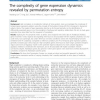Free Online Productivity Tools
i2Speak
i2Symbol
i2OCR
iTex2Img
iWeb2Print
iWeb2Shot
i2Type
iPdf2Split
iPdf2Merge
i2Bopomofo
i2Arabic
i2Style
i2Image
i2PDF
iLatex2Rtf
Sci2ools
BMCBI
2010
2010
The complexity of gene expression dynamics revealed by permutation entropy
Background: High complexity is considered a hallmark of living systems. Here we investigate the complexity of temporal gene expression patterns using the concept of Permutation Entropy (PE) first introduced in dynamical systems theory. The analysis of gene expression data has so far focused primarily on the identification of differentially expressed genes, or on the elucidation of pathway and regulatory relationships. We aim to study gene expression time series data from the viewpoint of complexity. Results: Applying the PE complexity metric to abiotic stress response time series data in Arabidopsis thaliana, genes involved in stress response and signaling were found to be associated with the highest complexity not only under stress, but surprisingly, also under reference, non-stress conditions. Genes with house-keeping functions exhibited lower PE complexity. Compared to reference conditions, the PE of temporal gene expression patterns generally increased upon stress exposure. High-c...
| Added | 28 Feb 2011 |
| Updated | 28 Feb 2011 |
| Type | Journal |
| Year | 2010 |
| Where | BMCBI |
| Authors | Xiaoliang Sun, Yong Zou, Victoria J. Nikiforova, Jürgen Kurths, Dirk Walther |
Comments (0)

